The Association for Mormon Letters’ AML Awards were presented online on April 29, 2023. You can watch the awards ceremony, emceed by Eric W. Jepson, and featuring remarks from many of the winners, at YouTube here. You can also see many of the award winners reading from their award-winning works at the end of the video. Below is each award winner, along with the award citation written by the judges.
Michel Hicks was presented with the Association for Mormon Letters Lifetime Achievement Award. Stephen Carter was presented with the Smith-Pettit Foundation Award for Outstanding Contribution to Mormon Letters. Their award citations will be published soon.
Novel
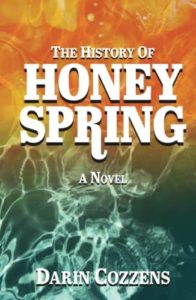 Darin Cozzens. The History of Honey Spring. Zarahemla Books
Darin Cozzens. The History of Honey Spring. Zarahemla Books
Twenty-one year old Jim Ray returns from Vietnam in 1966, but the only person to welcome him back doesn’t even know him: Nolan Rickett, an attorney who understands what it is to have no one. Rickett sets before Jim an opportunity he hadn’t seen coming–an inheritance of some 400 acres in Idaho, bequeathed to him by a surly uncle he’d never known. This revelation, however, comes with a small town feud and the festering wounds of a divided Mormon ward. Jim Ray just wants to build a life for himself, someplace safe, where he can bury his memories of war under the rich soil of newer, happier experiences of his own making. Honey Spring just might be that place, provided Jim can avoid the trips wires rigged against him by his uncle and the neighbor he hated.
In The History of Honey Spring, Darin Cozzens writes like a healer unbinding the wounds we didn’t know we had, letting sunlight and fresh air wash us clean of judgment and restore our kindness and our hope in humanity. A walk through Balfour, Idaho, side-by-side with Jim Ray, is the kind of healing medicine only offered by the best in literary fiction. Darin Cozzens is, indeed, the Mormon Wallace Stegner. So clear is his vision of human nature, so lyric his view of western America, so honest his storytelling that his artistry transcends the provincialism that has sometimes limited Mormon fiction to the boundaries of its own culture. The History of Honey Spring may well point the way forward for up and coming Mormon writers for generations to come.
Other finalists:
Jacob L. Bender. And All Eternity Shook
Declan Hyde. The Resurrection Box
Steven L. Peck. Heike’s Void
Short fiction
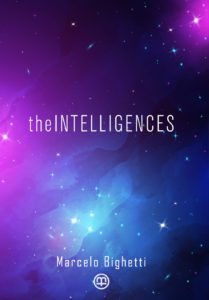 Marcelo Bighetti. “The Intelligences.” Irreantum 19:4, Winter 2022. (Originally “As inteligências.” Translated from Portuguese to English by Kent S. Larsen.)
Marcelo Bighetti. “The Intelligences.” Irreantum 19:4, Winter 2022. (Originally “As inteligências.” Translated from Portuguese to English by Kent S. Larsen.)
In Marcelo Bighetti’s “The Intelligences,” beings among the stars argue about their progression. Their knowledge is incomplete; some of the intelligences claim to have received messengers from higher states of being, and others seek insight among rebels and outcasts. Fearing a temporal interruption that might thwart their ascension from the Oblilish level to Kolob, the intelligences find themselves trapped by an apparent paradox. To progress in time, they must resort to opening Enish-go-on-dosh, a planet with ruling characteristics—but opening Enish-go-on-dosh will result in the stars’ incurring penalties, which may prevent them from progressing. At the same time, they contemplate an impossible rumor: that the Kolob level is subdivided into three levels, which are occupied by mere material beings!
“The Intelligences” explores thoughtfully our own limitations in following the plan of salvation by considering what constraints we might have suffered from in our pre-mortal existence. The story rejoices in an aesthetic flowing from the Book of Abraham, invites the reader to look backward as well as forward in pursuing her own path of exaltation, and strongly affirms a theology of love.
Other finalists:
Michaelbrent Collings. “The Profile of Daria Black”
Ryan Habermeyer. “The Algorithms of Happiness”
Tygan Shelton. “Worlds Without End”
Nathan Shumate. “Twilight of the Eye Creature”
Short Fiction Collection
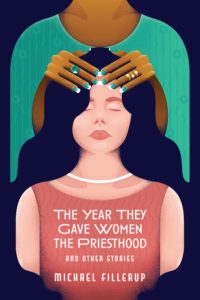 Michael Fillerup. The year they gave women the priesthood and other stories. Signature Books
Michael Fillerup. The year they gave women the priesthood and other stories. Signature Books
In The Year They Gave Women the Priesthood and Other Stories, Michael Fillerup afflicts his characters with a startling variety of sins and troubles: a man trapped in a tank in Kuwait meditates on his life as he waits for death from heat exhaustion; a man commits adultery in the mistaken belief that his polyandrous wife loves her other husband more; a father seeks revenge for his son who was murdered while on his mission; a peeping Tom watches his high school sweetheart having sex with her husband. Fillerup uses all these troubles to explore redemption or the lack of it. The stories are not didactic, not cautionary tales but variations on a theme, a distant cousin to Kierkegard’s Fear and Trembling, which retells the story of Abraham’s attempted sacrifice of Isaac from a variety of perspectives.
Kierkegaard and Fillerup both reach toward comprehending that which is beyond comprehension—the condescension of God as manifested through the Atonement. Again and again Fillerup’s flawed, complex characters approach the limit of their suffering and stumble forward. The result is a vision of life that is full of difficulty and blessing. One dying man recounts his prayer: “I thank him for those priceless moments on the mound throwing sidearm strikes to Andrew, and for fifty-one years on this beautiful planet, eleven years with beautiful Frieda. I thank him for the pioneer men and women of steel plodding across the wind-swept plains, wearing rags on their feet, pulling strips of rawhide from the handcart wheels and chewing them for dinner.”
The stories take on a variety of forms—a novella, the transcript of a confession, sudden fiction that reads like a prose poem, a letter. His sentences are exquisite: “They squeezed between two giant boulders constricted so tightly that, for Mark at least, coming out the other end felt like a birthing” and “A pregnant mutt, her swollen teats dragging along the snow, plodded towards the rock schoolhouse where Tom earned his daily bread.” While his endings are like the twist of a knife, flowing though the stories is Fillerup’s love for people, the earth, and God. In one of the most moving stories, a man drives into a blizzard with a bad truck, bad clothing, and the feeling he has wasted his life. What he discovers on his journey will knock readers back on their heels.
Other finalists:
Lee Allred. Down the Arches of the Years
William Morris. The Darkest Abyss: Strange Mormon Stories
Lehua Parker. Sharks in an Inland Sea
Poetry
 Kimberly Johnson. Fatal. Persea Books
Kimberly Johnson. Fatal. Persea Books
Reading Kimberly Johnson’s collection Fatal is like following the path of lightning: watching everything in its wake light up — fully charged —then burn. Every poem in this book crackles with heat: love — for dear ones, friends, lovers, children, parents, art, the earth — and pain at the threat of its loss. And the electric current, so robust in every poem, is the energy of Johnson’s mastery of language.
According to her notes, when Johnson’s first child was born, the world became fatal. Her book, Fatal, explores various aspects of dying—physically, emotionally and spiritually. Actuarial tables from the Center for Disease Control report on all mortality are interspersed through the book and serve as launching pads for poems. Sonically dazzling, she uses alliteration, assonance, rhyme and more to create a sort of dirge. And, as if in response to the terror of a suddenly frightening world, her poetry form is tight, almost (but not quite) uniform, composed mainly of tercets, with the middle line never exceeding five syllables. Each poem’s title begins with the letter f, as if riffing on an obsession. Her attempt to create order in chaos, safety in terror. Johnson’s book deals with the fragility of life and what makes it perilous, but at the same time celebrates life’s richness and language. This book is innovative, fresh, and new.
Other finalists:
Tyler Chadwick. Litany with Wings
Rio Cortez. Golden Ax
Danielle Beazer Dubrasky. Drift Migration
Scott Hales. Hemingway in Paradise and other Mormon Poems
Young Adult Novel
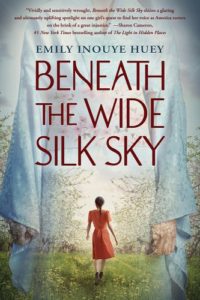 Emily Inouye Huey. Beneath the Wide Silk Sky. Scholastic
Emily Inouye Huey. Beneath the Wide Silk Sky. Scholastic
Drawing on family history, historical research, and her perceptive understanding of human nature, Emily Inouye Huey has written a compelling and poignant coming-of-age novel set on the edge of the United States’ entry into World War II. Sam Sakamoto, a high school girl and gifted young photographer, lives between two worlds—one enriched by her family’s Japanese heritage and the other governed by traditional, rural ‘American’ values—on a small island off the coast of Washington. Her mother’s recent death is only the beginning of conflicts that threaten her, her father, and her older brother and sister. Desperate to find a way to save the family farm from foreclosure, Sam hopes to use her skill to shoot a prize-winning photograph that will earn her enough money to help make the final payment on the mortgage. On December 7, 1941, her world is upended: nearly all of her white friends abandon her, and her family and the entire Japanese American community endure economic and personal threats triggered by racist fear mongering.
Huey’s eye for detail is as keen as Sam’s. Her authentic portrayal of Sam’s fear and confusion resonates with readers who, after feeling Sam’s complex turmoil, will gain an understanding of what it’s like to be excluded and abused because of one’s race. The historical context, especially the wartime rhetoric, provides a fully-developed snapshot of that dark moment in American history when a government imprisoned many of its own citizens. By focusing on the personal trials confronting Sam, her family, and friends instead of on the larger movement to round up and incarcerate Japanese Americans, Huey delivers a personal story of outrageous injustice and the toll it took on very real people.
Other finalists:
Orson Scott Card. Wakers
Joanna Ho. The Silence that Binds Us
Kara McDowell. This Might Get Awkward
Erin Stewart. The Words We Keep
Middle Grade Novel
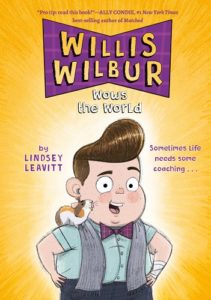 Lindsey Leavitt. Willis Wilbur Wows the World. Penguin Workshop
Lindsey Leavitt. Willis Wilbur Wows the World. Penguin Workshop
When Willis Wilbur’s summer plans fall through, he decides to do what any plucky nine-year old would: He makes a date with destiny. But destiny can’t take too long because Willis’s mom needs him busy during summer vacation. So, he draws up a proposal and negotiates two weeks to prove to his mom he can start his own business and win a local scholarship for young entrepreneurs.
But pro-tip #1: Starting a business is harder than it looks. Finding and maintaining clients, managing employees (especially when one is his even pluckier little sister), dealing with bullies who show up around every corner, navigating a summer without his best friend, and forging new friendships are all enough to make even the most intrepid (and best-dressed) almost-fourth-grader doubt if he will ever meet his destiny to become a famous life coach.
With her absolutely delightful voice, Lindsey Leavitt has created a charming character in Willis Wilbur who the reader will root for from beginning to end. While filled with real challenges any nine-year-old will face—such as bullying, disappointments, and tricky friendships—this fantastical story of a burgeoning life coach keeps the reader smiling throughout with upbeat messages, quick pacing, and punchy pro-tips. While children’s literature can at times be heavy—and rightfully so—Willis Wilbur Wows the World is a refreshing light, bright read that manages to tackle real topics with wit, clarity, and just the right bow tie.
Other finalists:
Dustin Hansen. The Legend of the Dream Giants
Amanda Rawson Hill. The Hope of Elephants
Jennifer A. Nielsen. Lines of Courage
J. Scott Savage. Secrets of the Looking Glass
Picture Books
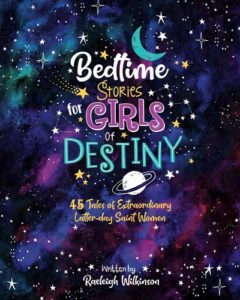 Raeleigh Wilkinson. Bedtime Stories for Girls of Destiny. Cedar Fort
Raeleigh Wilkinson. Bedtime Stories for Girls of Destiny. Cedar Fort
When telling stories from Latter-day Saint Church history, it’s easy to fall back on the same stories, over and over again. There’s a reason we go back to the same well, but it can be at the expense of telling a broader range of stories, which is especially a problem for people who don’t see themselves in the more common stories.
Bedtime Stories for Girls of Destiny relates brief life stories of 45 Latter-day Saint women. While there are some very well-known names in the book (such as Lucy Mack Smith), most of the stories are about women who are less well known, but no less important or inspiring. The women in this book are pioneers, missionaries, and Church leaders, but also artists, athletes, scientists, singers, and lawyers. They come from six continents and lived across four different centuries, including some who are still alive today.
Each story includes a full-page illustration by one of seven artists. While the choice of so many artistic contributors may have been a pragmatic one, it serves as a reminder that each of us will bring something different to these stories as we interact with and retell them, turning a book of 45 stories into a kaleidoscope of potentially infinite variation. That potential is an important message for all Latter-day Saint girls (and boys).
Other finalists:
Charlotte Jones Voiklis & Jennifer Adams (authors), Andelina Lirius (illustrator). A Book, Too, Can Be A Star: The Story of Madeleine L’Engle and the Making of A Wrinkle in Time
Annie Bailey (author) and Jen Corace (illustrator). Mud!
Shawna J. C. Tenney. Pirates Don’t Dance
Shannon Hale and LeUyen Pham. Pretty Perfect Kitty Corn
Creative Nonfiction
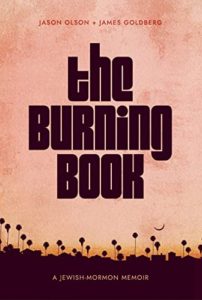 Jason Olson and James Goldberg. The Burning Book. BCC Press
Jason Olson and James Goldberg. The Burning Book. BCC Press
A good memoir requires an interesting true story—or, lacking that, the skillful and artistic telling of a true story. Jason Olson’s memoir, written in conjunction with James Goldberg, is both. What’s more, besides being both informative and artistically rewarding, this is a book that can nourish the reader spiritually. This religious memoir resists the easy constraints and motifs of the usual conversion story because it doesn’t end with an artificial “happily ever after” at baptism, but seeks to describe a mature, lifelong faith journey. This is a story of a quest to define one’s relationship with God and religion and to continue to refine and redefine it over a lifetime through interactions with other people and other faiths.
Jason Olson was raised as a practicing Jew in the Reform movement and, until encountering the Book of Mormon, was deeply committed to that life. His heritage provided him with a deep sense of the importance of God’s covenant with His chosen people, so that when he read the Book of Mormon for the first time, he was struck by the ways the book honors those ancient covenants and speaks to the covenant people. Through Olson’s eyes, LDS readers experience what it’s like to encounter the gospel through a Jewish lens. Aspects of the gospel such as a “sense of peoplehood, of a collective relationship between God and a people,” and the importance of temple worship take on a new dimension.
But this is not just a memoir of conversion. As with the best art, this is a book of tensions that are not resolved with easy, shallow answers—and sometimes, aren’t resolved at all. A life of faith is a holy wrestle, a continual willingness to engage with the Other, and this book shows a hopeful and honest way to do these things. Readers of all faiths can recognize here the yearnings, the negotiations, the balancing of convictions and relationships that are part of a living faith. In the narration of his work as a chaplain, Olson shows how honoring the good in all religions is a way of honoring one’s own religious commitments. Additionally, he models a Christ-like dialogue with those who differ politically. In his choice to embrace truth wherever it is found and be open to the Other, Olson demonstrates the Light of Christ in action. This book shows Olson’s embrace of the restored gospel as the beginning, not the end, of a lifelong quest for truth and Zion.
For its honest and fascinating view of a specific faith journey, its artistic skill in intertwining memoir and spiritual query, and its example of what it means to seek understanding of differences in religious and even political belief, the Association for Mormon Letters is pleased to award The Burning Book with the award for Creative Nonfiction, 2022.
Other finalists:
Phyllis Barber. The Precarious Walk: Essays from Sand and Sun
Michael Hicks. Wineskin: Freakin’ Jesus in the ‘60s and ‘70s
Rachel Rueckert. East Winds: A Global Quest to Reckon with Marriage
Criticism (Long-form)
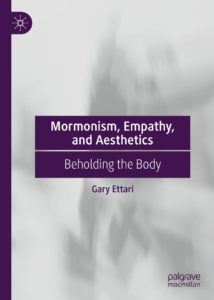 Gary Ettari, Mormonism, Empathy, and Aesthetics: Beholding the Body. Palgrave Macmillan
Gary Ettari, Mormonism, Empathy, and Aesthetics: Beholding the Body. Palgrave Macmillan
Gary Ettari’s monograph, Mormonism, Empathy, and Aesthetics: Beholding the Body, fruitfully explores a contested site in Latter-day Saint doctrine and practice: the physical body. For Latter-day Saints, the body is many things: it’s the vehicle for our spirits on their journey through mortality back to God—and something we should therefore operate with care lest we drift off course or crash, endangering our spiritual well-being. It’s an antenna for spiritual communication, opening us to the influence of godly and malevolent voices, which in turn affect our emotions—the godly leading to comfort and peace, the malevolent to discomfort and anxiety; hence, we should tune our desires to the godly by immersing in things virtuous, lovely, of good report, or praiseworthy. And it’s a mechanism for learning and gaining experience during mortality and of thereby becoming like our Heavenly Parents, who possess glorified bodies of flesh and bones through which they’ve attained knowledge and experience all things—and are, as such, able to guide and succor us.
If these corporeal metaphors seem to be at once at odds and entangled, that’s because they are. Bodies—and the cultural work they do—are a skein of desires, intentions, and meanings. Ettari deftly tugs at this knot in Beholding the Body, unraveling the string through Mormon theology, culture, art, and aesthetics. In the process, he weaves an aesthetic framework that both draws from and illuminates Latter-day Saint thought on embodiment, being, empathy, and community. Developing this framework and applying it to works by Mormon poets and painters, he exemplifies critical engagement with Mormon theological and cultural production and makes a potent contribution to the always expanding Mormon studies tapestry. Critics working within and speaking to Latter-day Saint cultural and artistic traditions will benefit from Ettari’s important and able work.
Other finalists:
Frederik S. Kleiner, Experiment upon the Word
Glen Nelson, John Held Jr.’s Fiction
Criticism (Short-form)
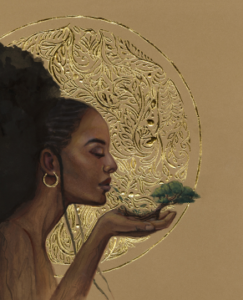
Margaret Olsen Hemming. “The Divine Feminine in Mormon Art.” Dialogue: A Journal of Mormon Thought 55:1, Spring 2022
If “the doctrine of a Heavenly Mother is a cherished and distinctive belief among Latter-day Saints,” observers might assume that official Church discourse often references the divine feminine (“Mother in Heaven,” Gospel Topics Essay). Yet Heavenly Mother is mostly absent from institutional Latter-day Saint discourse, Her marginal presence being in general subsumed in the preferred articulation of “Heavenly Parents.” This should, of course, be lamented and corrected. Simultaneously, as Margaret Olsen Hemming suggests in her vibrant and critical survey, “The Divine Feminine in Mormon Art,” the Mother’s relegation to canonical shadows has freed Mormon artists from dogmatic constraints, allowing for more openness, creativity, and diversity in how She is conceived and represented in Mormon aesthetic discourses. Here, as Hemming notes, commenting on artworks from a wonderfully diverse body of Mormon artists, Heavenly Mother emerges from and inhabits an “abundant multiplicity” (p. 34). Moving in the institutional margins, this abundance becomes a multi-vocal theology that liberates seekers from oppressive conditions “while also celebrating the diversity of … human experience” and expression (p. 4).
Hemming’s work in this survey participates in two broader contexts: on one hand, it emerges from and responds to a resurgent interest (within and beyond Mormonism) in the divine feminine; on the other, it’s inseparable from her ongoing labors to give presence and voice to oppressed bodies—within Mormonism, especially (see, for example, the two volumes of The Book of Mormon for the Least of These , co-written with Fatimah Salleh). We honor Hemming’s vital contributions to this broader cultural work. But we wish to recognize the importance and urgency of what she does in “The Divine Feminine in Mormon Art”: exploring the cultural potency of Mormon artworks representing the divine feminine, while also offering pointed critiques of Mormonism’s institutional structure and cultural discourse.
Other finalists:
Randy Astle, “Lands Before Time: Plan of Salvation Typology in the Films of Don Bluth”
Lane Welch, “Apologia Unmasked: Brigham City, Film Noir and the Future of Mormon Cinema”
Rosalynde Welch, “The Secular Syllabus and the Sacred Book: Literary Scholars Approach the Book of Mormon”
Comics
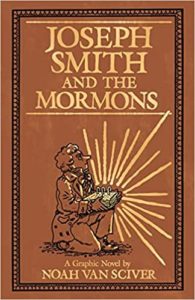 Noah Van Sciver. Joseph Smith and the Mormons. Abrams ComicArts
Noah Van Sciver. Joseph Smith and the Mormons. Abrams ComicArts
Noah Van Sciver’s Joseph Smith and the Mormons is a lifetime achievement, for Van Sciver, about a lifetime of achievements and failures by the prophet Joseph Smith. Van Sciver’s Smith is a boy visionary turned country prophet who is studious and vibrant, full of complexities, a many-layered life told through the panel language of the graphic novel. Van Sciver does not shy away from the foibles of Joseph Smith, yet remains an interested party to the claims of the Restoration with stunning depictions of vision, loss, violence, and love. We, the judges, believe Van Sciver has both elevated the representation of Joseph Smith through the visual medium while simultaneously memorializing the rich legacy of an American titan taken prematurely by a great intolerance. Guided by Paul’s admonition that “[i]f there is anything virtuous, lovely, or of good report or praiseworthy, we seek after these things,” we believe we have found such in the pages of Joseph Smith and the Mormons.
Other finalists:
Mark Elwood. The Glass Looker: Volume 2
Rachel Allen Everett. The Manderfield Devil
Doug Wagner (writer) and Tim Odland (artist). Beware the Eye of Odin
Special Award in Publishing: Republication
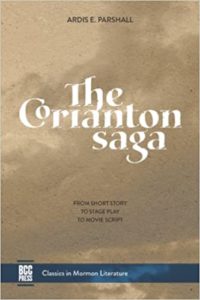 Ardis E. Parshall. The Corianton Saga: From Short Story to Stage Play to Movie Script. BCC Press
Ardis E. Parshall. The Corianton Saga: From Short Story to Stage Play to Movie Script. BCC Press
Ardis E. Parshall and By Common Consent Press are due, as ever, much credit and gratitude for the well-executed work of recovery and recontextualization done in The Corianton Saga. It brings together in legible, republished form five adaptations of the narrative of Corianton, the son of Alma so briefly described in the Book of Mormon; these adaptations come from four creators: B. H. Roberts, Julia A. MacDonald, Orestes U. Bean, and Zoan E. Houtz Bean. In these texts, we see Latter-day Saints stretch themselves as writers in the Home Literature movement precipitated by Orson F. Whitney, with their work eventually reaching Broadway, bringing Book of Mormon figures, names, dialogue, and plots in all their unorthodox, over-worded, yet endearing glory. Although familiar to “a handful of historians and Mormon literature enthusiasts,” these texts have largely been forgotten (p. xxvi).
Parshall’s sharply-written and comprehensively-sourced critical introduction prefaces the republished material, telling the story of the stories, a history sometimes as unexpected and gripping as the collected authors hoped their adaptations would be. Parshall is honest with her criticism (“few would consider it great literature,” she says of Roberts’s story [p. x]), but she is also effusive in her recognition of the signal ambition and achievement represented in these pages and her hope that by “bring[ing] the five major iterations of the Corianton Saga together for the first time in history … they can be read, enjoyed, discussed, dissected, and re-incorporated into Mormonism as part of its rich cultural heritage” (pp. xxvi–xxvii). Parshall’s hope is our hope, and if there is any vehicle for such reincorporation, it is The Corianton Saga. Thanks and congratulations for bringing these stories—and their history—out of obscurity and into light.
Other finalists:
Anne-Marie Wright Lampropoulos. A Vision Splendid: The Discourses of David O. McKay
Joe Monson. The Bacillus of Beauty, by Harriet Stark
Drama
 Reed McColm. The Wrong People Have Money. Varscona Theatre, Alberta, October-November. Shadow Theatre.
Reed McColm. The Wrong People Have Money. Varscona Theatre, Alberta, October-November. Shadow Theatre.
The Wrong People Have Money by Reed McColm opens with a college lecture delivered by Dr. Martin Delancey in direct address to the audience who, for a moment, are transformed into his eager pupils tasked with the impossible — tether the moon. Listing other examples, including space flight and a jello sculpture, Delancey explains that humanity can only push the edges of science and achieve new limits by attempting what seems impossible. Shortly after explaining to his class their assignment, a mysterious and sultry Madame D’Aulnoy, approaches Dr. Delancey. She represents a group of wealthy investors interested in securing the professor’s expertise on another impossible idea — moving Greenland miles south into the tropical zone of the Atlantic equator. This funny, startling opening presages a funny, startling play.
The premise might seem downright wacky, but the play manages that rare combination of delightfully funny and poignant. As Delancey and his team work on the problem of moving the entire island of Greenland 2.600 miles south, they encounter opposition from conservative activists, ministers in Greenland, and the laws of physics. Meanwhile, the worldwide media explodes into a firestorm of interest as an enthusiastic public catches hold of a vision of Greenland not just habitable but vacation-able. Some characters are over the top in moments of cartoonish romp, but this comedy has serious things to say about wealth inequality and media frenzy. Not overtly Mormon, LDS audiences are bound to be interested in the questions the play raises about what it means to “play god.”
The Wrong People Have Money was workshopped with Shadow Theatre and premiered at the Varsona Theatre in Edmonton, Canada. We are pleased to award it the AML Drama Award for 2022.
Other finalists:
Bekah Brunstetter (book) and Cinco Paul (story, music, and lyrics). A. D. 16
Julie Jensen. Mother, Mother: The Many Mothers of Maude
Melissa Leilani Larson. Mestiza, or Mixed
Film
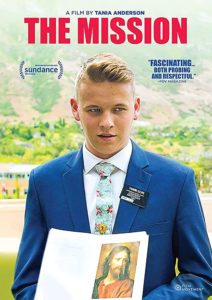 The Mission. Tania Anderson, director. Danish Bear Productions
The Mission. Tania Anderson, director. Danish Bear Productions
The Mission is a quietly remarkable film. With unprecedented access to missionaries, the MTC, and church services, The Mission follows four Latter-day Saint missionaries called to Finland (two men and two women) from before they enter the MTC until shortly after they have returned home. The documentary eschews talking heads and turning to outside commentary to help interpret the film for the audience. Instead, it chooses to simply follow these missionaries around, showing us what they do and say, peppered with their own observations and reflections. This choice, and the compelling selection of subjects, is one of the documentary’s greatest strengths–it remains somewhat difficult to parse how exactly Anderson or any of the other crew members feel about the missionaries, forcing you as the audience to sit with and confront your own feelings. Given my own missionary service, there was a wealth of thought and emotion called up by the film. The film is well shot and edited, keeping audience engagement throughout what could be boring stretches with relatively little ‘happening’. I would watch an entire 3, 4, 5 hour miniseries from Anderson following these, or other, missionaries!
The Mission offers viewers a taste of the strange, exhilarating mundanity of missionary service. It does this while granting its missionary subjects agency and personhood, forcing the viewer to really see them as young people, individuals, not automatons with badges (something that can even prove difficult for me to remember!). There is a wealth of narrative films about missionaries, many compelling, and amidst that wealth, The Mission is able to offer something different and worthwhile. And that is worth celebrating.
Other finalists:
The Brilliant Darkness! (Dem Toi Ruc Ro!). Aaron Toronto and Nha Uyen Ly Nguyen
Cheer. Season 2. Greg Whiteley
Lucy and Whitney. Parker Gehring
WWJD. Davey Morrison and Bianca Dillard
Religious Nonfiction
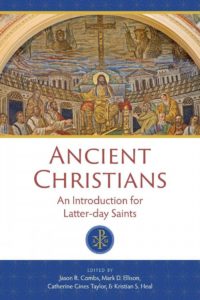 Jason R. Combs, Mark D. Ellison, Cathrine Gines Taylor, and Kristian S. Heal, editors. Ancient Christians: An Introduction for Latter-day Saints. Maxwell Institute
Jason R. Combs, Mark D. Ellison, Cathrine Gines Taylor, and Kristian S. Heal, editors. Ancient Christians: An Introduction for Latter-day Saints. Maxwell Institute
Ancient Christians: An Introduction for Latter-day Saints is a beautiful book. Whether it is approached intellectually, artistically, stylistically, or devotionally, readers will find much to linger on and to love about the winner of the AML award for Religious Nonfiction.
The book’s underlying logic, and its well-researched and well-documented chapters justify interest by scholars. Naturally, Latter-day Saint scholars of religion will want to read this book, but so will non-Latter-day Saint scholars who focus specifically on the intersection of Latter-day Saint and early Christian doctrine and practice. Even those who study early Christianity generally will find this book is an excellent resource. While the depth and precision will be of special interest to those who study these topics, Ancient Christians is written to appeal to a broad general audience and certainly to any interested member of the Church, a goal the book accomplishes with ease.
What is written in Ancient Christians is well worth reading, and the authors of Ancient Christians deserve applause individually for their excellent contributions. Chapter after chapter stands on its own in terms of excellent scholarship filled with keen and penetrating insights. The thirteen authors decipher complex doctrines, intricate historical developments, and theological twists and turns. They then communicate these insights to readers in readable prose—and they do so with honesty, openness, and faith. Reconciling historical moments that have been misunderstood or explaining theological differences (or similarities) between the modern Latter-day Saint church and the ancient church is difficult work. That these chapters consistently navigate the past with its inconvenient historical details and doctrinal perplexities is laudable. Writing about complex issues in simple, understandable language challenges the best of authors and is work no less worthy of praise. The editor-authors deserve extra applause for taking individual contributions and creating chapters that engage harmoniously with the other chapters and with the overall discussion in calm and friendly, almost conversational prose. That this readable scholarship is accomplished with sensitivity and faith is yet another reason why Ancient Christians is the winner of the AML award for religious nonfiction.
But readers will want to do more than read this book; they will want to hold and admire a work that is as well-crafted as it is well written. The hefty work is printed on glossy pages packed with full-color images of the art and material culture of ancient Christians. The works of art are not decorative add-ons or mere ornamentation. Pull-out boxes supply fascinating and connective commentary. The book demonstrates an admirable commitment to helping readers with various learning styles understand the worldview of ancient Christians as thoroughly as possible.
The art and text boxes also provide visual relief to what could become tiresome for some readers: pages of text. The relief of such visual breaks in the text is accomplished with consistent repetition of color and formatting, which inevitably unifies. Thus, the visual elements work in a brilliantly paradoxical manner: the same elements that break the text also smooth and soothe any authorial idiosyncrasies with an integrated layout. This thick anthology is less a compilation of different voices and more of an elegant whole.
Latter-day Saints who read this book will re-think assumptions about apostasy and restoration in light of the wide-ranging diversity of ancient Christianity. The positive, ecumenical approach of Ancient Christians frames ancient brothers and sisters as believers and disciples, but does so by noting differences and nuances that Latter-day Saints regularly overlook. The approach is creative, charitable, and generative. The humble mode of engagement will allow Latter-day Saints to engage with other believers on terms and in terms that will promote mutual understanding and will further on-going conversation.
Ancient Christians is an invaluable and beautiful book that will be an exquisite addition to any LDS Studies library for years to come.
Other finalists:
Daniel Becerra, Amy Easton-Flake, Nicholas J. Frederick, and Joseph M. Spencer. Book of Mormon Studies: An Introduction and Guide
Caroline Kline, editor. Mormon Women at the Crossroads: Global Narratives and the Power of Connectedness
Adam S. Miller. Original Grace: An Experiment in Restoration Thinking
Fatimah Salleh and Margaret Olsen Hemming. The Book of Mormon for the Least of These: Vol. 2, Mosiah-Alma
Podcast
 This Global Latter-day Life. Caroline Kline, host and writer. Claremont Graduate University, Claremont Mormon Studies Program.
This Global Latter-day Life. Caroline Kline, host and writer. Claremont Graduate University, Claremont Mormon Studies Program.
Half storytelling, half conversation, This Global Latter-day Life features the perspectives and life stories of Latter-day Saints from Botswana, Mexico, the Caribbean, and other countries around the world.
Based on oral histories from Claremont Graduate University’s Mormon collections, each episode tackles issues like race, culture, gender, and identity. Caroline Kline is the Assistant Director of the Center for Global Mormon Studies at CGU and is the host and writer for This Global Latter-day Life. Shiloh Logan is the primary audio editor.
This podcast is an impressive stand-out from an array of beautiful podcasts produced in 2022. The diverse oral histories are not only unique, they contextualize and broaden understanding of what belonging means in a world-wide church. The episodes draw listeners into rich backgrounds with global Latter-day Saint experiences before going further in depth with scholarly commentary and insight as guests explore questions and latter-day issues emerging from the oral history interviews.
Our judges called this podcast “engaging,” “well constructed,” “of the highest quality in sound, production, and content,” and concluded that This Global Latter-day Life “beautifully augments the conversation and scholarship of The Church of Jesus Christ of Latter-day Saints.” The stories and amalgamated commentary provided for these diverse Latter-day Saint experiences expands our vision and the horizon for what it means to be a member of the Church of Jesus Christ of Latter-day Saints.
Other finalists:
Come Follow Me Kids
Leading Saints
Tribe of Testimonies
Y Religion
